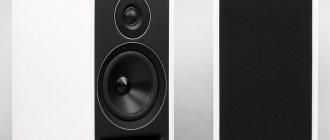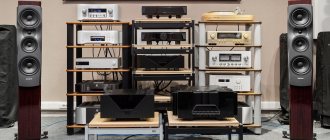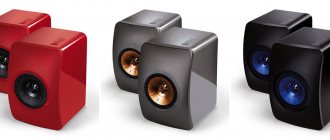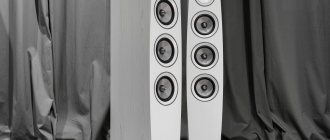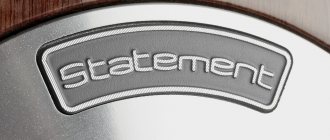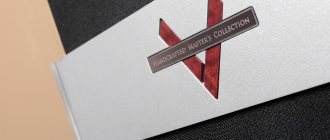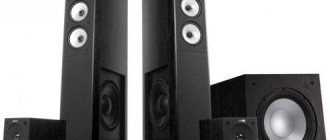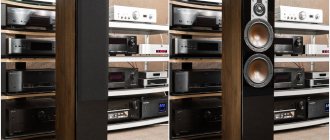About six years ago, the guys from Dynaudio decided that High End is, of course, cool, but Hi-Fi shouldn’t be discounted either. Moreover, its initial segment is the starting stage, so to speak. As a result of such thoughts, the Emit line of acoustics was presented to the world, which occupied a fairly budget niche relative to other Dynaudio speakers.
It must be said that even at that time there were already so many starting steps on the long Hi-Fi ladder that the line where they ceased to be starting steps clearly began to blur. What can we say about these days: the situation has only worsened, and competition in all segments has grown significantly. However, for us, discerning consumers, this is only a plus.
However, apparently, this state of affairs did not bother Dynaudio: it’s 2022 and the Emit line is back in service! Much has been updated and some has been replaced.
Therefore, today my task is this: using the Dynaudio Emit 20 bookshelf acoustics as an example, to evaluate all the tactical and strategic techniques of the Danes. Dynaudio has already won the war in this field more than once, but another difficult battle with experienced opponents is coming!
Re-release and premonition
If you visually compare both revisions of the Emit line of speaker systems, you will immediately be struck by the fact that the new series looks stricter. The result is a very Scandinavian design: maybe a little cool, but definitely stylish. And this is what all the speakers in the line look like - and there are, for a minute, as many as five models!
The youngest of them are Dynaudio Emit 10. Small but very nice bookshelf speakers. Next in the ranking are the heroes of our review - Emit 20. Their dimensions are already larger - and they can hardly be called small.
The floorstanding ones go even further: the smaller ones are the Dynaudio Emit 30, and the new addition to the line is the older Emit 50. They are already quite large, have three stripes and look very serious. There is a premonition that if they happen to enter into a similar battle with rivals in the niche, they will meekly retreat just from one glance at Emit 50: very strict, especially in black, and the laconic design is simply captivating!
There is also an Emit 25C center channel. Naturally, it was made in the same paradigm - and it also turned out to be handsome!
Dynaudio Emit M10 is an excellent speaker for small rooms
In CNet
A review of the Dynaudio Emit M10 compact bookshelf speakers has been published.
The author of the article entitled “An insanely great speaker for tiny rooms,”
famous audio expert Steve Gutenberg, continued his thoughts in the subtitle:
“ The Dynaudio Emit M10 is a dream speaker for audiophiles with small rooms.” “The Dynaudio Emit M10 is a dream speaker for audiophiles with small rooms.”
Here's what he writes about his impressions:
“I've always had a soft spot for high-quality speakers that really come to life in small rooms. The best ones are invariably tiny, and the Dynaudio Emit M10 monitor definitely qualifies as truly tiny because... its dimensions are only 170 x 292 x 240 mm.”
“I auditioned the Emit M10 at In Living Stereo in New York City, and I must admit that I have owned and listened to many Dynaudio speakers over the past almost 15 years. Despite this wealth of experience, the Emit M10 didn't sound quite what I expected. It was really nice, but much more lively and exciting than the ear-friendly, homey sound I associate with Dynaudio."
“A pair of Emit M10s opened up a huge wall-to-wall soundstage for me when I fired up Brian Eno's new album, The Ship. The first track is a disjointed ambient journey with a bubbling low bass base that I could hardly believe was coming from speakers as small as these. I was so completely engrossed in the slow swirl of Eno's sound and texture that I forgot I was listening to an Emit M10, I literally got lost in the slow swirl of Brian Eno's sound and texture." “I also listened to Nap Eyes' edgy album 'Thought Rock Fish Scale' to see how the Emit M10s handled rock, which they did with aplomb. It's hardly head-scratching music, but Nap Eyes recorded these tunes onto four-track tape with no overdubs, and before I knew it, I heard the music had a refreshingly direct sound, less processed and lively than most rock music. albums. Nap Eyes' crazy rhythms and Nigel Chapman's vocals were right there, planted firmly between two Emit M10s. Chapman sounds like Lou Reed at times and the band has a Velvet Underground vibe, but there's nothing overtly retro about Nap Eyes' music that I can rely on."
My short encounter with the Dynaudio Emit M10 left me with a deep respect for their capabilities, and I look forward to testing more Dynaudio models later.
Conciseness
We can say that Emit 20 are one of the most stylish bookshelfs in this segment, and they simply must receive some kind of award for this.
Some manufacturers are trying to make fancy cabinets, others come up with multi-colored grills, or pass off a bunch of mounting bolts as style. But real style doesn’t need to be explained, it can be seen just like that. In our case, these are snow-white and almost matte cabinets, two emitters and thin bevels on the edges above and below.
It seems that this is a special kind of art: the eye clings to it precisely when there seems to be nothing to cling to. This sophistication can be complemented by black grills, which will cover the front panel - but not entirely, but will leave small “gaps” at the top and bottom. This solution adds even more airiness to the already easy-looking design of Emit 20, even despite its not entirely compact dimensions and weight.
The body is covered with a film with a fine texture. Perhaps this is the only point where it was possible to find an attempt by Dynaudio to somehow reduce the cost of the Emit line. There is nothing to fear here, since the fit of the cabinet panels made of 18 mm thick MDF and the gluing is excellent everywhere: all seams and joints are simply perfect. In short, the Danes continue to follow their traditions in assembling cabinets - and this is good news.
The only decoration here is the “Dynaudio” inscription at the bottom of the front panel, which appears even when you put on the grill with magnetic mounts: it has the same nameplate, in the same place.
Arsenal
Apparently, the apparent brevity is aimed at dulling the vigilance of rivals - after all, what’s at stake... And what, by the way, is at stake? What are Dynaudio Emit 20 fighting for?
Judging by the price tag, this is no longer the starting level, since for 85,000 rubles there are now quite a lot of interesting offers: you can already find ribbon tweeters and all kinds of technologies there. But Dynaudio's brochures proclaim that "true hi-fi has never been so accessible."
Consequently, the struggle will be for high reliability, which must be skillfully seasoned with musicality, for the amount of detail that acoustics can convey to the listener, and for other nuances, by which each of us means Hi-Fi level sound.
Let's start exploring the arsenal. On the front panel there is a rather large-caliber driver with a diameter of as much as 18 cm. Apparently, here lies one of the tricks that most competitors should stumble over: in press releases Emit 20 are called “compact”, but in fact their height is almost 40 cm, width is slightly more 20 cm, and depth - more than 31 cm.
Not so compact. On the other hand, this immediately gives you a decent advantage over your rivals: a speaker with a diameter of 18 cm is no joke! What can I say: not all floorstanding speakers have speakers of this size.
Now let's take a closer look at the armament of these Dynaudios. In fact, the speaker responsible for low and mid frequencies in the Emit 20 is a long-throw proprietary Esotec+ driver with an equally proprietary diffuser made of MSP (magnesium silicate polymer) material. Absolutely all Dynaudio fighters use such weapons. Even if we look at the highest ranks - the Confidence line - they contain the same drivers.
But the internal structure of this emitter can allow you to win a battle without even showing up for battle. Of course: the Danes spent many years perfecting one of their main weapons.
If you look at it from the reverse side, it uses a special magnetic system called Ferrite+, which is assembled based on ceramic ferrite magnets and strontium carbonate. The design continues with a 52 mm diameter reel with a fiberglass frame and aluminum winding. The coil is then stabilized and centered with a Nomex washer, and the diffuser itself is directly glued to its rigid fiberglass frame.
Here we need to repeat ourselves: the diffuser is made of MSP material with a thickness of only 0.4 mm and has a very recognizable profile. First of all, because of the dust cap, which is part of the diffuser and has a characteristic dotted line of holes along the bend of its circumference. It’s impossible not to recognize this speaker, because it’s Dynaudio’s calling card.
This entire complex structure has proven its reliability over many years. Developers from Denmark say that excellent control, intelligibility and intelligibility of midrange and low frequencies in the performance of one driver are among the most important characteristics for a successful outcome of the battle.
As you may have guessed, the Emit 20’s HF driver is not so simple either. Its name is Cerotar, and it comes from the older line of Evoke speaker systems. This tweeter can be found with the already familiar Ferrite+ magnetic system (strontium carbonate) - here this magnet made it possible to increase the sensitivity of the driver, avoiding distortion.
Another feature of the Cerotar is the use of a double canopy. The outer one is a very soft dome with a diameter of 28 mm. And after it, another dome called Hexis was installed, which performs several functions at once. Firstly, it controls resonances and standing waves, and secondly, it works as “brakes” for the main dome. Because the tweeter also needs good control!
Well, the crossover: Dynaudio engineers say that its design was developed individually for the Emit 20. A first-order filter was used for the tweeter, and a second-order filter for the midrange/bass driver. Naturally, everything is assembled using time-tested parts.
This also includes a bass reflex port on the rear panel, which looks like the barrel of a rifled weapon, and a docking station for speaker wire with two terminals. From the technical side, everything here is done well. But if we return to aesthetics, the heads of the screws that secure the panel to the cabinet could have been made flush, and it would have been nice to have built it in a little more neatly. Probably, after looking at the perfect façade, my eye was immediately drawn to the small design flaws on the “dark side of the moon.”
Dynaudio Emit 20: Two-way monitors
We continue our acquaintance with the new budget line of the Danish manufacturer. Next in line are the older bookshelf speakers number 20. Dynaudio has always been particularly good at two-way compacts - such iconic models as, for example, the S25, S40 and Heritage Special had a monitor form factor.
Let's see what results the new development from Skanderborg will demonstrate.
By the way, let me remind you that Dynaudio was one of the first to remove the term bookshelf speakers from use, replacing it with standmount speakers. This seemingly insignificant fact says a lot: the company positions its compact two-way monitors as full-fledged playback systems for a serious stereo complex, and not just for dubbing rear channels in home movies.
It is rightly said that creating a budget product is much more difficult than an expensive one, if, of course, you prioritize the ratio of quality and price. It took several years to design and fine-tune the Emit models: when I visited the Dynaudio R&D center in 2017, prototypes of the Emit were already being tested there, and the series had only entered the market a few months ago.
It is rightly said that creating a budget product is much more difficult than an expensive one, if, of course, you prioritize the ratio of quality and price.
Danish specialists took the creation of their budget models more seriously than ever. Let me remind you that shortly before our visit, the largest chamber in Europe for measuring the parameters of acoustic systems was put into operation at the Dynaudio center. A unique “Jupiter” system, created by the company’s specialists, is installed in a cubic room measuring 13 x 13 x 13 meters. A movable bracket lifts the column under study to a height of 6.5 m, and during the measurement process it rotates and tilts it in different directions. In front of it is a huge arc with 31 microphones, which also rotates when taking angular characteristics. After a complete measurement of the speaker (this takes about 25 minutes), a 3D model of the sound field created by it is built. The room allows you to obtain reliable results down to 40 Hz, and the engineers emphasize that this is not an anechoic chamber - only two walls and a ceiling are damped, which allows you to record reflections, as in real listening conditions.
The Jupiter system was also used in the creation of the inexpensive Emit 20. Like the floor-standing “fifties,” their design uses some components from the Evoke series, which is one step higher in the Dynaudio hierarchy. In particular, 18-centimeter mid-bass speakers with diffusers made of the proprietary MSP composite with an optimal ratio of weight and rigidity. This material was developed in-house by Dynaudio and has been used for many years in its most famous models. The peculiarity of the diffuser is that it is made integral with the dust cap, due to which the forces transmitted from the voice coil are better distributed. In addition, the large central hemisphere itself becomes a radiator, adding a little upper middle. And note the enhanced dual magnet system - this driver is clearly designed to reproduce sharp dynamic contrasts. This is also facilitated by a lightweight voice coil wound with copper-plated aluminum wire on a heat-resistant fiberglass frame. In combination with a bass reflex, this head begins to reproduce bass from 50 Hz.
The Cerotar tweeter we already know (also installed in the Evoke model) has a 28 mm fabric dome and a powerful magnetic system made of ferrite with strontium carbonate. The rear diaphragm (a Hexis patented design) dampens the dome's rear radiation, flattening the frequency response and reducing distortion in the high frequencies.
The crossovers were developed by the same team that created the Heritage Special and Core models. A first-order filter is used for the high band, and a second-order filter for the mid-bass band. Traditionally for Dynaudio, they are designed so that the impedance of the monitors is as linear as possible, without dips. Accordingly, the phase characteristic is also equalized.
The crossovers were developed by the same team that created the Heritage Special and Core models. A first-order filter is used for the high band, and a second-order filter for the mid-bass band.
Emit 20 is finished with high-quality laminate in black or white and with imitation walnut veneer. Magnetic grills in any version are black.
Dynaudio also offers stands for its monitor speakers in black and white. For Emit 20, fairly massive Stand 20 designs are recommended (RUB 47,650 per pair).
Our listening path turned out to be laconic: an Audiolab 8300CD CD player in conjunction with the familiar Rotel RA1572 Mk II integrated circuit.
And here is the answer to the question why Dynaudio engineers chose a two-way design for the most important anniversary models. A pair of good speakers in well-built housings when dividing the range with the simplest filters is a 100% guarantee of a wow effect, especially for an inexperienced listener. Monitors build an extremely vivid spatial picture with almost material sound images. The secret is simple - two closely spaced speakers with almost coherent radiation and minimal phase distortion in the crossovers create a real hologram. This is typical for expensive Dynaudio monitors, but I never expected to get anywhere near the beauty of the experience from the Emit 20, an entry-level model. Simplifications in design compared to older lines did not lead to dramatic changes in sound. On some tracks, the “twenties” disappear as physical objects, and the sound picture is built as if without their help. If you listen to them in the near field, you can get such sharp localization that it seems as if you are sitting in giant headphones.
This is typical for expensive Dynaudio monitors, but I never expected to get anywhere near the beauty of the experience from the Emit 20, an entry-level model.
Small nonlinear distortions at mid frequencies (Dynaudio really knows how to make speakers) is the key to unobtrusive detail and natural timbres. Acoustic instruments, singing voices from bass to soprano - everything sounds alive, without a “plastic” aftertaste. And the fact that almost the entire range of information that is significant for our hearing is reproduced by one speaker is another advantage of two-way acoustics.
The bass, of course, is not as deep here as in the recently tested Emit 50, but since there is no artificial merging with the mids, this range seems to be a smooth continuation of the lower mids and is perceived very comfortably. For such unity and clarity of the entire sound basis, one can easily forgive the lack of tectonic depths. Another related point is an excellent sense of rhythm, because the entire set of percussion instruments, except metal ones, is transmitted by one diffuser. There is no desynchronization either on complex compositions or on fragments with a syncopated rhythm. Both the kick and snares work as one unit.
If you listen to them in the near field, you can get such sharp localization that it seems as if you are sitting in giant headphones.
The tweeters do not disturb the overall balance, gently continuing it towards the upper overtones. Subtle string reverberations, cymbal vibrations that reach the very edge of audibility, airy and noise components - all this harmoniously fits into the overall musical picture.
Based on personal experience, I will say: some speakers may sound very beautiful, but their veracity is often questionable. In the character of Dynaudio acoustics there is neither festive brightness, nor clearly expressed expression, nor any super-detail, but from the general impression you completely believe them. And this kind of comprehensive “believe it or not believe it” assessment is, in my opinion, the most important.
SYSTEM
- CD player Audiolab 8300CD
- Integrated amplifier Rotel RA1572 Mk II
- Cables: Transparent Cables MusicWave interconnects
- acoustic Transparent Cables MusicWave Plus
- network Transparent Cables Premium
Dynaudio Emit 20
Manufacturer: Dynaudio International GmbH (Denmark)
www.dynaudio.ru
Configuration: 2 emitters, 2 bands || Acoustic design: bass reflex || Frequency range: 53 - 25,000 Hz (± 3 dB), 42 Hz - 35 kHz (- 6 dB) || Sensitivity: 86 dB (2.83 V/1 m) || Recommended Amplifier Power (IEC): 160W || Nominal impedance: 6 ohms || Crossover frequency: 3800 Hz || Finish: black, white, walnut || Dimensions 205 x 370 x 312 mm || Weight 1 piece: 10.32 kg || Price per pair: 85,790 .
share
Tags: DynaudioDynaudio Emit 20
Weapons for battle!
It’s rare when a real high-fi battle ends immediately after the “rattling of the arsenal” - this is not our way, not the audiophile way. Therefore, having secured the support of the Rotel RA-1572 MKII integrated device and the Rotel RCD-1572 CD player, we move on to the most active stage - listening.
Here it must be said that Dynaudio acoustics are very partial to warming up. So much so that when you get ready to go into the demo room to listen to the Emit 20 or any other Dynaudio speakers, ask: did they get warm? Well, let them play before you arrive - it will only be beneficial.
The sensations from the first track made me immediately forget its name. It was jazz without vocals, with pleasant double bass parts. A well-recorded kick drum would periodically enter, a trumpet would play, and percussion would be delivered in measured doses.
This type of bass is more often found in floor-standing speakers. The kick turned out to be very convincing: both in terms of mass and texture - there is no doubt that this is a real bass and a real kick, with its own aftertones and vibrations. It turned out very nice.
Immediately the insidious double bass made an attempt to mix the mass of the drum with the trembling of its strings. It was as if I was playing on the opposing side, honestly! But the Emits also prepared and did not succumb to provocation. As a result, the double bass was on our side - it and the kick drum turned out to be a wonderful duet!
Continuing to analyze the unknown track, let's turn our attention to the pipe. Because the gradients, in which improvisation-like passages fluttered across the stage, had very wide tonal boundaries - what is needed to evaluate the mid-frequency range.
The NSF zone repeated the success of the combination of a kick drum and a double bass, but this time in the duet of a double bass and a trumpet - and it was not possible to find problem areas in this range. The presentation is smooth, with a moderate attack speed and correct decays - it seems that we have arrived at the first signs of authenticity, because of which, in fact, it all began!
Now let's take a little pipe and wait until its tonality jumps to the point where, by the will of strontium carbonate, the tweeter begins to wield percussion. The result is a pleasant and harmonious, “comfortable” symphony: the high frequency zone is slightly allocated to a plan close to the first. The same thing happened with vocal tracks - in the voices of the same Norah Jones (Norah Jones) or Madeleine Peyroux (Madeleine Peyroux) you can find a spark, and it will sound comfortable, but clearly. In fact, this is a good indicator if we go down the path of seeking authenticity.
It turns out that Emit 20, calm and cool in appearance, can play naturally and emotionally. Perky and sophisticated - it also works. But the most important thing is that in any genre they manage to maintain a good balance in tonality and attack speed. The deep bass is worked out as deeply as possible, but does not overshadow everything and everyone with its mass: at the same time, languid baritones can intertwine with cellos - and all this is perfectly organized even at decent volume levels!
If the vocals are higher, they won't make you squint your eyes, but at the same time, it doesn't feel like something has been taken away from the vocals. And the percussion is just a berry! At one moment they can be called pleasant and affectionate, but as soon as you change the track to something more aggressive, everything will change dramatically.
Let the battle end now, because the first casualties are visible on the horizon.
